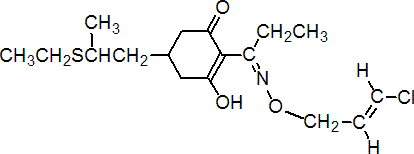|
clethodim
Herbicide
HRAC A WSSA 1; cyclohexanedione oxime

NOMENCLATURE
Common name clethodim (BSI, ANSI, draft E-ISO); clétodime ((f) draft F-ISO)
IUPAC name (?-2-[(E)-1-[(E)-3-chloroallyloxyimino]propyl]-5-[2-(ethylthio)propyl]-3-hydroxycyclohex-2-enone
Chemical Abstracts name (E,E)-(?-2-[1-[[(3-chloro-2-propenyl)oxy]imino]propyl]-5-[2-(ethylthio)propyl]-3-hydroxy-2-cyclohexen-1-one
CAS RN [99129-21-2] Development codes RE-45601 (Chevron)
PHYSICAL CHEMISTRY
Composition Tech. is >91% pure. Mol. wt. 359.9 M.f. C17H26ClNO3S Form Clear, amber liquid. B.p. Decomposes below boiling point. V.p. <1 ´ 10-2 mPa (20 ºC) S.g./density 1.14 (20 ºC) Solubility Soluble in most organic solvents. Stability Aqueous hydrolysis DT50 28 d (pH 5), 300 d (pH 7), 310 d (pH 9). Aqueous photolytic DT50 (sterile buffers, pH 5, 7 and 9) 1.7-9.6 d (without photosensitiser), 0.5-1.2 d (with photosensitiser).
COMMERCIALISATION
History Herbicide reported by R. T. Kincade et al. (Proc. 1987 Br. Crop Prot. Conf. - Weeds, 1, 49). Introduced by Chevron Chemical Co. Patents GB 2090246 Manufacturers Arvesta; Shenyang
APPLICATIONS
Biochemistry Fatty acid synthesis inhibitor, by inhibition of acetyl CoA carboxylase (ACCase). Mode of action Systemic herbicide, rapidly absorbed and readily translocated from treated foliage to the root system and growing parts of the plant. Uses Post-emergence control of annual and perennial grasses, at 60-240 g/ha, in a wide range of broad-leaved crops (including such field crops as soya beans, cotton, flax, sunflowers, alfalfa, peanuts, oilseed rape, sugar beet, tobacco, and potatoes), vegetable crops, trees and vines. To be used with a non-phytotoxic crop oil concentrate. Phytotoxicity Good tolerance in broad-leaved crops. Formulation types EC. Compatibility Antagonism has been observed when tank-mixed with 'Basagran' or 'Blazer'. Selected products: 'Select' (Arvesta, Valent, Bayer CropScience)
OTHER PRODUCTS
'Centurion' (Arvesta); 'Conclude Xtra G' (BASF); 'Prism' (Valent) mixtures: 'Compas' (+ bromoxynil octanoate) (Bayer CropScience); 'Conclude Xtra' (+ acifluorfen-sodium+ bentazone-sodium) (BASF)
ANALYSIS
By hplc.
MAMMALIAN TOXICOLOGY
Reviews FAO/WHO 86 (see part 2 of the Bibliography). Oral Acute oral LD50 for male rats 1630, female rats 1360, male mice 2570, female mice 2430 mg/kg. Skin and eye Acute percutaneous LD50 for rabbits >5000 mg/kg. Moderate skin irritant (rabbits). Not a skin sensitiser (guinea pigs). Inhalation LC50 (4 h) for rats >3.9 mg/l (total aerosol). NOEL for mice 30, rats 16, dogs 1 mg/kg daily. ADI (JMPR) 0.01 mg/kg b.w. [1999]; 0.16 mg/kg (Canada); 0.01 mg/kg (USA). Toxicity class WHO (a.i.) III (company classification); EPA (formulation) III
ECOTOXICOLOGY
Birds Oral LD50 for bobwhite quail >2000 mg/kg. Dietary LC50 for mallard ducks >6000 mg/kg. Fish LC50 (96 h) for rainbow trout 67, bluegill sunfish >120 mg/l. Daphnia LC50 (48 h) >120 mg/l; NOEC 60 mg/l. Algae EC50 (5 d) for fresh-water algae 57.8 mg/l. Bees LD50 (contact) >100 mg/bee. Worms LC50 for worms 454 mg/kg soil; NOEL 316 mg/kg soil.
ENVIRONMENTAL FATE
Animals Metabolised to the sulfoxide and sulfone. Plants Metabolised to the sulfoxide, sulfone and S-methyl sulfoxide. Soil/Environment Aerobic DT50 in soil 1-3 d. Kd 0.08-1.6 (5 soil types).
|